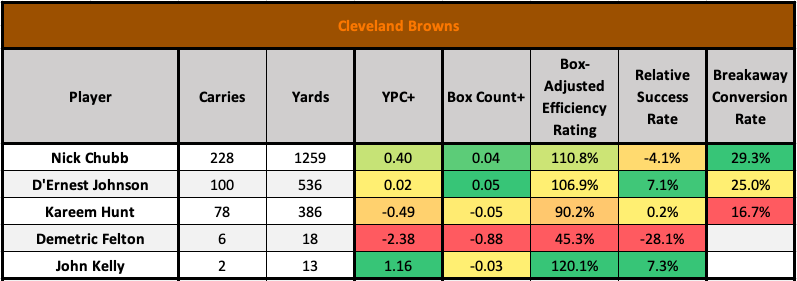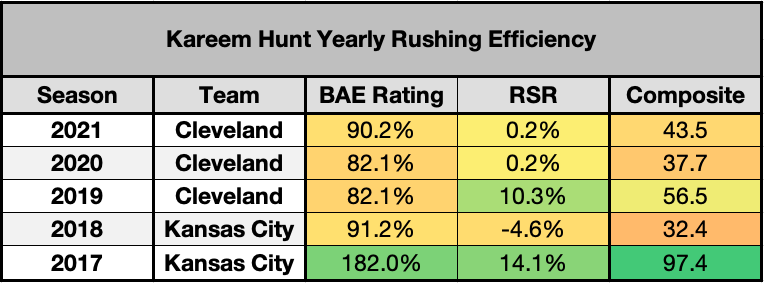The 2022 Browns Backfield Breakdown is part of an offseason series in which I take a deep dive into one NFL team’s backfield and examine the respective rushing performances of the players in it. In doing so, I hope to gain insights into key players from a talent evaluation standpoint, and using that evaluation as a baseline, from a dynasty valuation standpoint. The first installments in the series can be found here.
I’ll start by taking a quick overview of each team’s raw rushing volume and propensity to run the ball in general, and then dive into the player evaluation portion. Before we start, let’s define the metrics I’ll use as part of those evaluations:
Key Metrics
Yards per Carry+ (or YPC+)
The degree to which a player’s raw yard per carry average exceeds or falls short of the collective yard per carry average of all other running backs on his team. Meant to be an overview of a player’s team-relative efficiency.
Box Count+
The degree to which the average amount of defenders in the box that a player faces on his runs exceeds or falls short of the collective average faced by the other running backs on his team. Considering that the outcome of any given rushing attempt is largely dependent on the amount of defenders in the box pre-snap, Box Count+ describes the relative degree of difficulty of a running back’s carries.
Breakaway Conversion Rate (BCR)
Quantifies performance in the open field by measuring how often a player turns his chunk runs of at least 10 yards into breakaway gains of at least 20 yards.
Box-Adjusted Efficiency Rating (BAE Rating)
Improves upon YPC+ by accounting for the box counts that a player carried the ball against. Looks at team-relative yards per carry against each individual box count, then uses a weighted average (based on total carries against each box count) to generate an overall score. A score of 100-percent indicates that a player is producing exactly the per carry output of his teammates, a score above 100-percent indicates that he is outdoing their per carry output to whatever degree, and vice versa for a score below 100-percent.
Relative Success Rate (RSR)
Measures player consistency using Success Rate, but relative to his teammates and adjusted for the box counts that he faced in the same way that BAE Rating is. “Success” on a given carry is defined by gaining 40-percent of yards needed on first down, 70-percent of yards needed on second down, and 100-percent of yards needed on third or fourth down. A score of 0.0-percent indicates that a player is succeeding on exactly the same percentage of his carries as are the other backs on his team, a positive score indicates that he is succeeding more often than his teammates are, and vice versa for a negative score.
Team Rushing Volume
The Cleveland Browns were top-10 in the NFL in rushing attempts in 2021. They finished with 34 more than league average, and were even run-heavier in 2020. They had 64 more carries than league average and finished with the fourth-most attempts that season.
According to rbsdm.com, the Browns were No. 13 in the league in early-down run rate in neutral Game Script situations (when win probability for either team did not exceed 80-percent) last season, and No. 12 in the same metric in 2020. Through two seasons of the Kevin Stefanski era, Cleveland has shown a consistent philosophical commitment to running the ball.
That commitment was clear in nearly every down-and-distance situation last year. They opted to run more often than expected (given league-wide play-by-play data) across the board; and 5-percent more often than expected overall.
To some extent, that philosophical bent makes sense considering the talent configuration of the Browns offense. Baker Mayfield has been a disappointment and they have not trotted out great pass-catchers. Relying on their Pro Bowl-quality running backs seems reasonable. Changes are surely to come with the arrival of Deshaun Watson.
Efficiency Numbers
It’s been a two-man show with Nick Chubb and Kareem Hunt at running back in Cleveland for a few years now. But D’Ernest Johnson stepped into a sizable role with Hunt out for multiple games last season. With Demetric Felton and John Kelly also in the mix, here are the full rushing efficiency profiles for every Browns runner to carry the ball in 2021:
Chubb has a reputation as one of the best pure runners in the league. The numbers generally back that up, but with a caveat. He’s posted a BAE Rating in at least the 66th-percentile in every season of his career. But the only season in which he had positive marks in BAE Rating and RSR was his rookie campaign back in 2018. With Breakaway Conversion Rates consistently above the 70th-percentile, he’s a big-play back with high overall efficiency to show for it. But he generally does not produce positive outcomes on his runs at a high rate relative to his teammates.
The “other” guy in Cleveland has been Hunt. His performance in 2021 is fairly emblematic of the type of player he’s been his whole career:
The composite scores here represents the average between the percentile ranks of Hunt’s yearly BAE Rating and RSR marks. Since an incredible rookie season, Hunt has just not been a very good runner. He consistently has lagged behind the overall efficiency of the other runners on his teams. And he generally hasn’t produced positive outcomes on his carries at an impressive rate.
D’Ernest Johnson
D’Ernest Johnson has been an objectively more effective runner than Kareem Hunt in the last two years. On 33 carries in 2020, Johnson posted a 100.8-percent BAE Rating to Hunt’s 82.1-percent. On 100 carries in 2021, his 106.9-percent BAE Rating and 7.1-percent RSR combine for a composite efficiency score of 71.1. That mark is significantly higher than the composites for both Hunt and Chubb. And it puts Johnson in the company of only Darrell Henderson, Chase Edmonds, and Khalil Herbert; as guys who had at least 100 rushing attempts in non-lead back roles with efficiency composites above the 70.0 mark.
So Now What?
The second-best running back on the Browns is D’Ernest Johnson, not Kareem Hunt. He’s one of the few best backup running backs in the league. And he deserves the same kind of sleeper/handcuff buzz in dynasty that guys like Khalil Herbert get. Johnson is also in a unique situation among handcuffs. He’s able to step into legitimate volume with an injury to either Hunt or Nick Chubb. His likelihood of fantasy utility is doubled in relation to guys like Alexander Mattison; players who are useless unless the single player ahead of them misses time. There’s also the possibility that Hunt becomes a cap casualty and Johnson is the undisputed RB2 in Cleveland.
At this point in his career, Chubb is what he is. He’s a big, dynamic runner whose upside is capped by the presence of other quality players in his backfield and his own limitations as a pass-catcher.
The other guys for Cleveland are not very notable. John Kelly and Tre Harbison are the ancillary backs who are currently under contract. Neither of them are worth paying attention to.
Final Word
The improvement in quarterback play we’re likely to see when Deshaun Watson takes over for the Browns will be the tide that lifts all boats. Nick Chubb should see the lion’s share of that boost. And D’Ernest Johnson is a sneaky beneficiary as an under-the-radar stud who is likely to be usable in fantasy lineups in 2022. He’s one of the best throw-in trade targets in dynasty.





